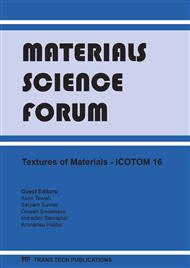[1]
T. Leffers, R.K. Ray, The brass-type texture and its deviation from the copper-type texture, Prog. Mater. Sci. 54 (2009) 351-396.
DOI: 10.1016/j.pmatsci.2008.09.002
Google Scholar
[2]
J.S. Kallend, G.J. Davies, The development of texture in copper and copper-zinc alloys, Texture, 1 (1972) 51-69.
DOI: 10.1155/tsm.1.51
Google Scholar
[3]
G. Wassermann, Der Einfluss mechanischer Zwillingsbildung auf die Entstehung der Walztexturen kubisch flächenzentrierter Metalle, Z. Metallkde. 54 (1963) 61-65.
DOI: 10.1515/ijmr-1963-540201
Google Scholar
[4]
T. Leffers, P. Kayworth, Twinning and texture, in: 3e Colloque Européen sur les textures de déformation et recristallisation des métaux et leurs applications industrielle (ICOTOM 3), Société Francaise de Métallurgie, Paris, 1973, pp.149-171.
Google Scholar
[5]
T. Leffers, J. Bilde-Sørensen, Intra- and intergranular heterogeneities in the plastic deformation of brass during rolling, Acta Metall. Mater. 38 (1990) 1917-(1926).
DOI: 10.1016/0956-7151(90)90303-x
Google Scholar
[6]
B.J. Duggan, M. Hatherly, W.B. Hutchinson, P.T. Wakefield, Deformation structures and textures in cold-rolled 70: 30 brass, Metal Sci. 12 (1978) 343-351.
DOI: 10.1179/030634578790433909
Google Scholar
[7]
J. Wang, J.H. Zheng, K. Sekine, Rolling texture evolution of Ag and Ag-Zn alloys having very low stacking fault energies, in: Z. Liang et al. (Eds. ), Proceedings ICOTOM 11, International Academic Publishers, Beijing, 1996, pp.362-367.
Google Scholar
[8]
O. Engler, C. Pithan, K. Lücke, Rolling texture development in Cu-Mn alloys, Mater. Sci. Forum, 157-162 (1994) 679-683.
DOI: 10.4028/www.scientific.net/msf.157-162.679
Google Scholar
[9]
O. Engler, Deformation and texture of copper-manganese alloys, Acta Mater. 48 (2000) 4827-4840.
DOI: 10.1016/s1359-6454(00)00272-x
Google Scholar
[10]
J.S. Kallend, G.J. Davies, A simulation of texture development in f. c. c. metals, Phil. Mag. 25 (1972) 471-490.
Google Scholar
[11]
P. Van Houtte, Simulation of the rolling and shear texture of brass by the Taylor theory adapted for mechanical twinning, Acta Metall. 26 (1978) 591-604.
DOI: 10.1016/0001-6160(78)90111-6
Google Scholar
[12]
S.R. Kalidindi, Modeling anisotropic strain hardening and deformation textures in low stacking fault energy fcc metals, Int. J. Plasticity, 17 (2001) 837-860.
DOI: 10.1016/s0749-6419(00)00071-1
Google Scholar
[13]
T. Leffers, P. Van Houtte, Calculated and experimental orientation distributions of twin lamellae in rolled brass, Acta Metall. 37 (1989) 1191-1198.
DOI: 10.1016/0001-6160(89)90114-4
Google Scholar
[14]
S. Ahzi, S. M'Guil, A. Agah-Tehrani, A new formulation for the elastic-viscoplastic lower bound and intermediate modeling for polycrystal plasticity, Mater Sci. Forum, 408-412 (2002) 463-468.
DOI: 10.4028/www.scientific.net/msf.408-412.463
Google Scholar
[15]
T. Leffers, The brass-type texture once again, in: Z. Liang et al. (Eds. ), Proceedings ICOTOM 11, International Academic Publishers, Beijin, 1996, pp.299-306.
Google Scholar
[16]
W.F. Hosford, The orientation changes accompanying slip and twinning, Text. Cryst. Solids, 2 (1977) 175-182.
DOI: 10.1155/tsm.2.175
Google Scholar
[17]
T. Leffers, R.A. Lebensohn, Ambiguities in the calculation of lattice rotations for plane-strain deformation, in: Z. Liang et al. (Eds. ), Proceedings ICOTOM 11, International Academic Publishers, Beijin, 1996, pp.307-314.
Google Scholar
[18]
R.A. Lebensohn, T. Leffers, The rules for the lattice rotations accompanying slip as derived from a self-consistent model, Text. Microstruct. 31 (1999) 217-230.
DOI: 10.1155/tsm.31.217
Google Scholar
[19]
S. Tiem, M. Berveiller, G.R. Canova, Grain shape effects on the slip system activity and on the lattice rotations, Acta Metall. 34 (1986) 2139-2149.
DOI: 10.1016/0001-6160(86)90159-8
Google Scholar
[20]
K. Wierzbanowski, M. Wronski, A. Baczmanski, B. Bacroix, P. Lipinski, A. Lodini, Problem of lattice rotation due to plastic deformation. Example of rolling of f. c. c. materials, Arch. Metall. and Mater. 56 (2011) in press.
DOI: 10.2478/v10172-011-0061-5
Google Scholar
[21]
A.J. Beaudoin, P.R. Dawson, K.K. Mathur, U.F. Kocks, A hybrid finite element formulation for polycrystal plasticity with consideration of macrostructural and microstructural linking, Int. J. Plasticity, 11 (1995) 501-521.
DOI: 10.1016/s0749-6419(99)80003-5
Google Scholar
[22]
G. Winther, Slip systems, dislocation boundaries and lattice rotations in deformed metals, Risø-R-1686(EN), 2009, pp.65-71.
Google Scholar
[23]
C.S. Lee, B.J. Duggan, Deformation banding and copper-type rolling textures, Acta Metall. Mater. 41 (1993) 2691-2699.
DOI: 10.1016/0956-7151(93)90138-i
Google Scholar
[24]
T. Leffers, O.B. Pedersen, The activation energy for the fcc rolling-texture transition as related to the activation energy for cross slip, Scripta Mater. 46 (2002) 741-746.
DOI: 10.1016/s1359-6462(02)00065-9
Google Scholar


